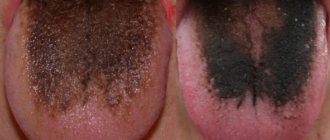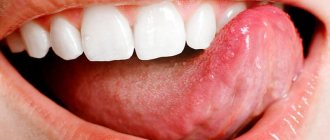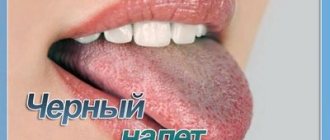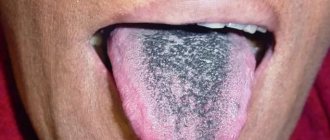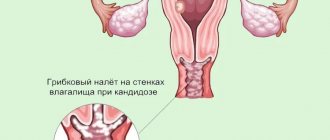What is thrush
Thrush (or candidiasis) is a type of stomatitis (inflammation of the mucous membrane in the mouth) caused by a yeast-like fungus of the genus Candida. It is this fungus that causes the disease, usually transmitted through contact with an infected person.
The fungus is not a “guest” in the body: like other microorganisms, it always lives on the mucous membranes of the intestines, genitals, and mouth, but in small quantities. However, such a normal state is possible only with a “friendly” balance of “good” and “harmful” bacteria representing the microflora of the human body. This balance of equilibrium can be disrupted upon contact with a patient with thrush: in this case, a fungal infection from the outside enters the body of a healthy person and begins to multiply quickly there, disrupting the natural microflora.
This is possible when the immune system is weakened, when the number of “good” bacteria sharply decreases, and they are unable to fight the growing number of “harmful aliens.”
The occurrence of thrush in the mouth in children over the age of one year is explained by the fact that when they come into contact with each other, they pass toys and objects that they take in turn in their mouths, and among them there is often at least one child infected with candidiasis. And since the child’s immunity is still in the development stage, its internal protection is weakened, so infection occurs very quickly.
Is stomatitis contagious?
Infectious variants of the disease are quite easily transmitted from sick children to healthy ones. Most often, the infection spreads through airborne droplets from saliva during normal talking, coughing or sneezing.
The herpes virus can pass from an infected mother to the child during childbirth or during breastfeeding in the event of an exacerbation of herpetic inflammation.
We must remember that some forms of infectious stomatitis may well be transmitted through shared objects. This is especially true for cutlery, toys and personal care products. Therefore, if a child gets stomatitis, it is necessary to take measures aimed at preventing the possibility of its transmission to healthy children.
- If there is another child in the family, then it is worth protecting him from communication with the sick baby for at least a few days.
- It is imperative to provide the patient with individual household items that can be processed separately from the belongings of the rest of the family.
- If a case of stomatitis is detected in a kindergarten, it is recommended to disinfect all toys that healthy children may come into contact with.
Symptoms of thrush in the mouth of a baby
What does thrush look like in a baby? When a fungal infection enters the child’s oral mucosa, its proliferation leads to inflammation in the mouth area. Therefore, quite quickly you will be able to notice small crumbs of white “cereal”, reminiscent of cottage cheese, on the child’s cheeks, palate, gums and tongue. An inexperienced mother may well assume that this is the remains of milk or formula after regurgitation. But checking whether this is so is quite simple: take dry sterile gauze or a bandage and very carefully try to remove the white coating. If these are really leftover food, they will be easily removed; if it is thrush, it will be more difficult to erase the curdled coating. And after removing it, you will notice inflamed redness in the oral cavity. If your baby has thrush, his appetite and sleep will most likely worsen, and he will become restless and moody.
Pathogen dossier
What are the causative agents of the disease? Candida fungi are present almost everywhere: in the air, on the surface of any objects, including food, which means they can be transmitted by air, through food, or by contact. They are also present in limited quantities in the human body. With a decrease in immunity, hormonal changes, long-term use of antibiotics or dysbacteriosis, our body ceases to restrain their reproduction, which causes inflammatory processes on the skin and mucous membranes. Candida feed on sugar, releasing toxins that help reduce the body's immune properties. The main cause of thrush in children is the Candida albicans (white) strain. Of the variety of known varieties of fungi of this genus, the most dangerous strains are Candida lusitanlae, Candida glabrata and Candida krusei, which are resistant to some antifungal drugs.
Causes of oral thrush in newborns
How can Candida fungi get into a baby’s body?
- infection can occur during the mother’s pregnancy if she suffers from genital candidiasis on the eve of childbirth: during the birth process, a fungal infection enters the placenta and amniotic fluid, and then into the newborn’s body;
- a baby can also become infected from a nursing mother if her nipples are affected by a fungal infection;
- when a child is bottle-fed or sucks on a pacifier, it, as well as bottles and nipples, must be treated in a sterilizer or boiled water before giving it to the newborn; unsterile nipples can cause bacteria to enter the oral cavity;
- the fungus can live not only on the mucous membrane, but also on the skin of the hands, from where it can easily migrate to the skin of the child if he is cared for by a person affected by thrush;
- The fungus can also be found in pet hair, dust, raw vegetables, meat or milk, so after contact with all these “transmitters” of bacteria, you must wash your hands thoroughly before touching the newborn;
- treatment with antibiotics can also disrupt the natural balance of the body's microflora; as a result of antibiotic therapy, candidiasis occurs in mother and baby who did not take medications containing “beneficial” bacteria along with antibiotics;
- candidiasis can occur if the mother has not learned how to properly attach the baby to the breast during feeding; the child may swallow too much air when sucking and, as a result, often burp; under such circumstances, most of the dairy food can remain in the child’s mouth, giving rise to fermentation processes and promoting the proliferation of fungi.
- thrush often develops in premature babies because their immune defenses are still too weak;
- candidiasis during artificial feeding can affect the baby due to the fact that he does not receive substances from mother’s milk that suppress the growth of fungal microflora;
- if the mucous membranes in the child’s mouth often dry out due to too dry air in the room or thirst, then such situations can contribute to the development of thrush;
- if the child’s immunity is reduced due to illness, poor sleep, lack of vitamins, then this can also cause fungi to multiply;
- candidiasis can also have a chronic form: in this case, it is often caused by serious illnesses in the child - diabetes, leukemia, HIV.
What kind of pasta should a child under 3 years old have?
If we look at clinical studies that were conducted on the principles of evidence-based medicine, the main component in children's toothpastes is fluoride. Only they confirm their effectiveness in preventing caries.
However, it is widely believed that children under 3 years old should not brush their teeth with fluoride toothpaste. This position is due to the risk of developing fluorosis due to an excess of fluoride in the body - destruction and darkening of the enamel. But an excess of this substance is possible only in areas with a high fluoride content in water, and is also due to genetics.
The fluorine content in water can be checked on the Russian water map. And the genetic predisposition can be determined by the attending physician after passing tests. If the quality of drinking water is normal and tests are normal, dentists usually recommend using a toothpaste with a low concentration of fluoride (up to 500 ppm) at an early age.
In addition to fluorides, it is recommended to look at the abrasiveness of the paste (up to 50 RDA), as well as the presence of therapeutic and preventive additives in the composition: enzymes, xylitol, herbal extracts.
What to look for in the composition when choosing a paste:
- Abrasives - An alternative, non-traumatic but effective abrasive is silica. It is worth giving preference to toothpastes containing this substance.
- Fluorides - Organic fluorine contains compounds such as amino fluoride (olaflur).
- Dairy enzymes - lactoferrin, glucose oxide, lysozyme, lactoperoxidase. All of them stimulate the development of beneficial microflora, strengthen local immunity and restore the acid-base balance of the oral cavity.
- Xylitol is a natural sugar substitute with properties beneficial for teeth and gums. It prevents the growth of bacteria and reduces the risk of caries.
Biorepair Kids toothpaste with strawberry flavor (from 0 to 6 years)
Apadent Kids toothpaste with strawberry and grape flavor (from 0 years old)
Toothpaste Brush-Baby Apple-mint (from 0 to 3 years)
Toothpaste Mamiae Strawberry up to 6 years
Dangers of candidiasis for a newborn
Candidiasis can occur in simple and complex forms. And depending on the degree, it contains certain dangers:
- in severe forms of thrush, the fungus can reduce immunity and disrupt the gastrointestinal tract;
- candidiasis in a girl can spread to the vaginal mucosa, creating the risk of a pathology called synergy - fusion of the labia or vaginal mucosa;
- a mild form of thrush, in which it is enough to treat the plaque, usually does not pose any danger;
- with moderate thrush, inflammation forms under the white coating, which begins to bleed during treatment; this form brings additional discomfort and pain to the child; in the absence of proper treatment, the disease can become more severe;
- in severe cases of the disease, the fungal infection spreads throughout the entire oral cavity; in addition to pain and discomfort, the child may have a fever; Difficulties with swallowing can lead to the baby refusing not only food, but also water, which leads to rapid dehydration; this condition is life-threatening for the child, so its treatment is sometimes carried out in a hospital;
- thrush can occur not only in the acute, but also in the chronic stage: in such cases, exacerbation is characterized by the appearance of plaque on the mucous membranes and dry mouth; as a result of the infection spreading to the skin, small ulcers appear in the corners of the child’s mouth, and dense lymph nodes become noticeable to the touch under the jaw; reddish inflammations acquire a brownish tint and become painful, their area increases.
Symptoms of stomatitis
Signs of stomatitis in a child have a number of features characteristic of a particular type of disease.
Herpetic stomatitis in children is considered very common and usually manifests itself as follows:
- in the initial stage, the disease is confused with a cold due to increased body temperature, often runny nose and cough;
- the inflammatory process begins abruptly, manifested by headaches and pain in the mouth and muscles due to intoxication of the body;
- submandibular lymph nodes are enlarged and painful;
- feature - the formation of small bubbles filled with liquid.
Upon visual examination, redness of the gum tissue around the teeth, swelling of the mucous membrane and numerous vesicular rashes covered with a yellowish or whitish coating are noted. Candidal stomatitis in children can be clinically acute or mild. In this case, signs of stomatitis in a child appear as follows:
- very rarely an increase in temperature is recorded;
- in the oral cavity there are affected areas covered with a coating of cottage cheese;
- children behave restlessly, are capricious, refuse to eat;
- Locally similar stomatitis in children (or thrush, as it is often called) occurs on the tongue, cheeks, gums and inner lips).
Aphthous stomatitis in children is the most common form of the disease, but also difficult to treat due to the difficulty of identifying the specific pathogen. Similar stomatitis in children, the symptoms of which are more common in schoolchildren than in the younger age group, is characterized by the following symptoms:
- rash of single ulcers (feed) on the mucous membrane (on the cheeks, in the area of the tongue and the inside of the lips);
- Initially, such stomatitis in children in the mouth is manifested by characteristic redness, itching, burning, and an increase in temperature is also noted.
In this case, the ulcers do not look like blisters, but are whitish ulcers with a bright red outline around them. Then the ulcers are usually covered with a cloudy film, which can break through and cause a secondary infection, after which the baby’s condition will only worsen. Parents should know that stomatitis in a child is not a single type of infection with specific symptoms.
Each form of this inflammatory process has its own specific symptoms and causes. That is why, despite a number of individual similar points (temperature during stomatitis in a child, signs of inflammation of the mucous membrane, enlarged lymph nodes), the problem of treating stomatitis in a child is solved differently, taking into account the form of the disease.
Is research necessary?
Usually, thrush in the mouth of a baby does not require additional research, since it is not difficult for an experienced specialist to diagnose it based on obvious signs. But sometimes, in case of serious lesions, additional studies may be prescribed:
- microscopic: in this case, the doctor will take scrapings from the oral mucosa to examine the yeast-like fungal cells more carefully;
- bacteriological: during such a study, a scraping is also taken and then bacteria are cultured to understand how large the volume of fungal colonies is and how amenable to treatment they are with antifungal drugs; in addition, bacteriological testing helps determine which drug is the most effective in treatment, because some of them may not have an effect in the treatment of thrush;
- serological: this study requires a blood test, in the serum of which antibodies to fungal infection are examined.
Caring for a child with stomatitis
Parental involvement in treatment and proper care of children is not only important, but also necessary. With stomatitis, it is necessary to strictly follow the treatment plan, which is often very labor-intensive, so the result depends on parental care and control. The oral cavity is a kind of epicenter of pain, so it is not surprising that the child is very temperamental. Therefore, it is important for parents to be patient and persistent.
Most mothers and fathers are concerned about what to feed their child with stomatitis. Firstly, you need to eat only soft, warm and pasty foods, such as purees. The main thing is that the food is high in calories and not heavy, because the child’s immunity is already weakened. After eating, be sure to rinse your mouth so as not to provoke the development of stomatitis and not to add an additional infection. Spicy, sour, sweet and citrus foods should be excluded from the child's diet.
For stomatitis in children, it is necessary to relieve pain. This is done with the help of various medications to avoid food refusal and poor sleep. Also, for stomatitis in children, adequate oral treatment is very important. Your doctor should recommend how to handle your child and rinse his mouth.
How to treat oral thrush in infants
Treatment of oral thrush in an infant is not a complicated process, but it requires the systematic implementation of certain procedures several times a day until the child recovers. If you find a mild degree of thrush in your baby, but at the moment you cannot call a doctor (for example, on a day off), then you can use traditional methods of eliminating thrush. If the degree of damage to the mucous membrane has already reached serious forms, it is better not to risk it and call an ambulance.
Traditional methods for eliminating thrush:
- using a soda solution: prepare a solution (dissolve 1 teaspoon of soda in a glass of warm boiled water), then wrap a sterile bandage around your finger, moisten the winding in the solution and very carefully wipe the areas of fungal infections; Do not rub them under any circumstances, because under the plaque there may be bleeding plaques, through which you risk allowing bacteria to enter the baby’s body; such light rubbing can be done 4 times a day until you have the opportunity to visit a doctor;
- use of honey solution: prepare a solution (dissolve 1 tsp honey in 2 tsp warm boiled water); however, please note that it is unacceptable to use a honey solution if a child is allergic to bee products; if the child tolerates honey well, then treatment with the solution can be carried out similarly to treatment with soda; You can also treat your baby’s pacifiers and toys, which he likes to put in his mouth, with any of these solutions;
- for candidiasis of the nipples, treat them with any of the above solutions;
- You can use other natural antiseptics for rinsing and treating the oral cavity - for example, herbal infusions; you can prepare a decoction of chamomile, green tea, calendula, taking 1 tsp. dry herbs for 1 cup of boiling water; Sage, elecampane, yarrow, burdock, and oak bark also have antiseptic properties, but it is also necessary to understand that any of the herbal preparations can cause an allergic reaction;
- sometimes the contents of aloe vera stems are used as antiseptics, lubricating the affected areas with this juice;
- Among the natural oils that can be used to lubricate the oral cavity, rosehip, flax or peach oils can be used after rinsing or treating plaque.
Rules for oral care up to 3 years
Only good hygiene can help avoid caries. To ensure effective brushing, follow these rules.
- You need to brush your teeth twice a day, in the morning after breakfast and in the evening before bed.
- The correct brush movements are sweeping, from the gums to the tip of the tooth.
- Don't forget about the inner surface of your teeth.
- Show your child that you enjoy brushing your teeth. Set an example for him.
Your child’s first impressions of going to the dentist depend on oral hygiene. When the rules are followed and caries does not occur, communication with the doctor is reduced to medical examinations and does not leave terrible memories for life.
In the future, the child will trust the dentist and will tolerate possible procedures more easily. This means that caries will be treated on time and will not lead to complications.
All the most necessary hygiene products for children from 0 to 3 years old are collected in our children's set No. 1. It includes:
- Splat Baby toothpaste with apple and banana or vanilla flavors with a fingertip included;
- Curaprox Curakid toothbrush;
- Gel Pansoral “First teeth”;
- Brush Baby wipes with xylitol;
- Toothbrush holder Miradent Funny Animals.
These are basic products that will help your child maintain healthy oral microflora and fight tooth decay.
Self-medication precautions
When choosing methods for self-treatment of oral thrush in a baby, you need to understand that sometimes such procedures may not correct the situation, but on the contrary, harm the child.
For example, improper use of soda solution when treating the oral mucosa can cause additional injuries. Therefore, carefully prepare the soda solution, not exceeding its concentration more than 1-2%, because a stronger concentration leads to a burn to the mucous membrane.
You can complicate the situation with candidiasis by using a honey solution. After all, beekeeping products are one of the most powerful allergens, so when using them you need to be absolutely sure that there is no allergic reaction.
In addition, when using herbal infusions, do not use several herbs at the same time. In this case, if an allergy suddenly arises, you will know which plant caused it.
Similar folk recipes can be used when treating an older child, but it is better not to experiment with the baby’s health. If the situation is urgent and you cannot see a doctor today, it’s better to play it safe and call an ambulance. At your appointment at the clinic, your doctor will prescribe medications to combat the fungal infection. When treated with medications, you can avoid additional risks, and candidiasis will go away faster.
Angular stomatitis in a child
Causes
In children, seizures are most often a manifestation of allergies, and can also appear while taking antibiotics. The mechanism is as follows: when using antibiotics, the microflora of the oral cavity is disrupted (both harmful and beneficial microbes die), against this background, space is freed up in which Candida fungi settle. It is these fungi that eventually cause the formation of buttocks.
Similar erosions can appear against the background of herpetic lesions, injuries, allergies, dry lips and cracks. It is important to determine the cause of their appearance and only then prescribe treatment.
Symptoms
Angular stomatitis (jams) - erosions with crusts that appear in the corners of the mouth - is also a fairly common form of stomatitis.
Treatment
- Antiseptics (chlorhexidine, miramistin) - use a gauze swab or ear stick to treat the surface of the wound.
- Keratoplasty (solcoseryl, oil solution of vitamins A and E) - applied to a dry surface after antiseptic treatment.
- Fighting the cause of the disease (if it is an allergy, we remove the allergens and prescribe antihistamines, if it is due to antibiotics, we prescribe drugs to restore the microflora and antifungal ointments, etc.).
Treatment of thrush with medications
If the treatment is prescribed correctly, then after a couple of days the child will feel much better even with a severe form of the disease. However, this does not mean that taking the drug should be stopped - it is necessary to complete the full course of treatment until all symptoms of candidiasis are eliminated.
Thrush that is not completely treated is at risk of returning during the next vaccinations or during the baby’s teething period. During such periods, do not use the previously prescribed medication yourself and under no circumstances increase the dosage of the medications. After all, an increased dose of an antiseptic can provoke the opposite effect - the occurrence of bacterial stomatitis due to the proliferation of pathogenic microflora. Independent and uncontrolled use of medications is always risky because beneficial bacteria living on the surface of the mucous membranes may die, and their place will quickly be taken by pathogenic microorganisms. Therefore, wait for a doctor’s appointment, who will accurately determine the required dosage of the drug.
In addition, in parallel with drug treatment, do not forget about treating your baby’s nipples, bottles and toys: they can be regularly boiled and kept in a soda solution. When breastfeeding, do not forget to wash your nipples before each time your baby latches on.
Diagnosis of oral mycosis
Most often the diagnosis is obvious. However, in difficult situations, for example, in the presence of complications or individual intolerance to certain drugs, to confirm it, microscopic and cultural analysis of scrapings from the surface of the mucous membrane is used to determine the sensitivity of the microflora to antifungal drugs. Moreover, the mere presence of Candida threads in scrapings from the oral cavity is not always enough to make a diagnosis - fungi can be present in the mouth, but not cause any diseases. In such a situation, quantitative assessment is important, that is, counting the pathogen cells, and increasing their number when re-analyzed after 2-3 days.
Up to contents
To prevent your baby from getting thrush
To prevent thrush from reaching the baby’s mucous membranes, special precautions must be taken:
- Regularly care for your child’s mucous membranes, monitor their condition when the baby is sick, and especially when he suffers from infectious diseases;
- If your child is prescribed antibacterial drugs, be sure to remember to use special means to protect the microflora;
- If candidiasis occurs during pregnancy in an expectant mother, it is necessary to urgently consult a doctor and undergo treatment. In addition, on the eve of birth, maternity hospitals carry out special prophylaxis for newborns with an increased risk of candidiasis. Thrush is especially susceptible to infants whose mothers suffer from chronic candidiasis and those who have foci of infection already in the immediate vicinity of birth. Mothers with inflammatory gynecological diseases or difficult childbirth can also transmit the risk of fungal infection to the newborn.
How to prevent the disease
So, what will help avoid an “outbreak” of fungal infection?
- Careful oral care.
- Solving dental problems and treating common diseases.
- Compliance with the rules of personal hygiene, hygiene of infant feeding and care1.
- Mandatory treatment of the disease during pregnancy and after childbirth1.
- Prophylactic use of antifungal agents, for example, during treatment with antibiotics and immunosuppressive drugs (radiation or chemotherapy)1.
Important: frequent outbreaks and severe cases of candidiasis are a reason to consult a doctor and undergo a full examination. Taking into account the fact that mycoses develop against a background of reduced immunity, they can act as a marker of serious diseases2. According to the World Health Organization, recurrent candidiasis should be a reason for testing for HIV.
Up to contents
Prevention of thrush
Considering the reasons for the development of thrush in children, it is worth noting ways of prevention .
The most important thing: during pregnancy, a woman must carefully monitor her health, follow personal hygiene and doctor’s recommendations, including those related to nutrition.
If you have thrush, it is advisable to reduce your consumption of sweets, flour, and fatty foods, increasing the proportion of vegetables, fruits, and whole grain bread in your diet.
Early breastfeeding after childbirth promotes the formation of normal intestinal microflora in the child, which prevents the proliferation of opportunistic microorganisms. When artificial feeding and using pacifiers and nipple shields, it is important to sterilize these items in a timely manner. For a newborn, it is not enough to pour boiling water over a bottle or pacifier: up to six months, boiling or using a sterilizer is required. In the second half of the year, the child begins to lead a more active lifestyle, so-called domestic infection occurs, while the baby’s immunity increases, and the need for sterilization disappears.


